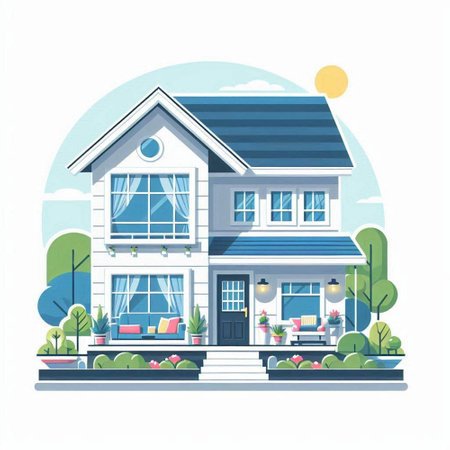Introduction to Smart Home Energy Management
As the United Kingdom embraces a future defined by sustainability and refined living, smart home energy management systems are rapidly becoming an integral feature within modern British homes. These innovative technologies are transforming how households monitor, control, and optimise their energy consumption—delivering not just convenience but also tangible environmental benefits. In essence, a smart home energy management system connects various appliances and utilities through intelligent automation, empowering residents to make informed decisions about their energy use. As concerns around climate change and rising energy costs intensify, the adoption of such systems is no longer just a trend for tech enthusiasts; it’s increasingly viewed as a practical solution for eco-conscious homeowners across the UK who wish to blend efficiency with elegant living. This growing importance is reshaping both the aesthetic and functional landscapes of contemporary British interiors, setting a new standard in sustainable design and everyday comfort.
Energy Consumption in UK Households
The UK is renowned for its distinctive architectural heritage, yet this very charm often presents unique challenges when it comes to energy efficiency. Traditional British homes, many of which date back to the Victorian and Edwardian eras, were constructed long before modern energy-saving innovations became mainstream. As a result, these properties frequently struggle with draughty windows, insufficient insulation, and inefficient heating systems. In the context of creating more sustainable living spaces, understanding how energy is consumed across UK households is essential.
Patterns of Energy Use
Typical UK households rely heavily on gas for central heating and hot water, while electricity powers lighting, appliances, and increasingly, electric vehicles. The energy demand tends to peak during the colder months due to heating requirements—a reflection of the country’s temperate climate. Despite ongoing improvements in building regulations and awareness campaigns, average household consumption remains a critical area for environmental focus.
Key Challenges in Achieving Sustainability
- Older Housing Stock: With around 20% of homes built before 1919, retrofitting can be both technically complex and costly.
- Cultural Habits: Daily routines such as frequent kettle boiling and extended use of immersion heaters contribute to higher per capita energy use compared to some European counterparts.
- Fragmented Upgrades: Piecemeal improvements—like fitting double glazing or loft insulation without addressing the entire building envelope—can limit overall impact.
Breakdown of Household Energy Use in the UK
| Category | Percentage of Total Consumption |
|---|---|
| Space Heating | ~55% |
| Water Heating | ~17% |
| Lighting & Appliances | ~23% |
| Cooking | ~5% |
This snapshot underscores why rethinking domestic energy management is crucial. The environmental benefits of smart home solutions become evident when we consider the scale of energy used simply to maintain comfort in traditional settings. As homeowners seek to blend timeless design with future-forward efficiency, innovative strategies will be key to reshaping how we live—and how lightly we tread on the planet.

3. How Smart Technologies Reduce Environmental Impact
Across the UK, smart home technologies are quietly transforming the way we consume energy, making our daily routines both more efficient and environmentally conscious. At the heart of this transformation are innovative solutions such as intelligent thermostats and connected lighting systems, each playing a distinct role in minimising household carbon footprints. By finely tuning heating schedules to match occupancy patterns and external weather conditions, smart thermostats ensure that no watt is wasted—an especially significant advantage given Britain’s variable climate.
The Role of Intelligent Thermostats
Intelligent thermostats, like those commonly found in British homes, adapt to users’ behaviours and preferences, learning when to reduce heating during unoccupied periods or lower settings overnight. This not only leads to noticeable reductions in gas and electricity consumption but also directly supports the UK’s ambitious targets for carbon reduction. As more households adopt these systems, the collective impact is profound: less demand on the national grid and a tangible cut in greenhouse gas emissions.
Connected Lighting for Sustainable Living
Equally impactful are connected lighting solutions. These systems allow homeowners to control lighting remotely via smartphones or automate usage based on daylight availability. In densely populated urban environments like London or Manchester, where energy demand peaks during evening hours, connected lighting can significantly flatten consumption curves. By illuminating spaces only when needed—and often using low-energy LED bulbs—residents actively contribute to reducing overall energy wastage.
A Holistic Approach to Energy Management
The synergy between these smart technologies exemplifies a holistic approach to energy management in UK homes. When layered together with other smart devices—such as automated blinds, occupancy sensors, or integrated energy monitoring platforms—the potential for lowering environmental impact grows exponentially. Collectively, these innovations empower residents not just to save on their bills but to be active stewards of a cleaner, greener Britain.
4. Integration with the UK’s Renewable Energy Efforts
The transition towards a more sustainable future in the United Kingdom is underpinned by the nation’s commitment to increasing its renewable energy capacity. Smart home energy management systems (SHEMS) play an instrumental role in harmonising domestic energy consumption with the dynamic influx of green electricity from sources such as wind, solar, and hydroelectric power. By intelligently adapting to fluctuations in grid supply, these systems help homeowners align their energy use with periods of peak renewable generation, maximising environmental benefits while reducing reliance on fossil fuels.
Synergy Between Smart Homes and Renewables
SHEMS are designed to seamlessly interact with the smart grid infrastructure that is rapidly expanding across the UK. Through real-time data exchange, these systems can automatically adjust heating, cooling, and appliance usage based on both household needs and grid conditions. For example, when wind turbines off the coast of Scotland generate surplus electricity during blustery nights, SHEMS-equipped homes can be prompted to store this clean energy for later use or shift high-energy tasks—like charging electric vehicles or running washing machines—to these greener windows.
Benefits of Integrated Energy Management
| Benefit | Description |
|---|---|
| Optimised Consumption | Smart scheduling ensures electricity is used when renewable supply is highest, minimising carbon footprint. |
| Grid Stability | By smoothing out demand peaks and troughs, SHEMS support a more resilient and reliable national grid. |
| Cost Savings | Homeowners can benefit from lower tariffs during times of surplus renewable energy generation. |
A Localised Approach: The UK Context
The UK’s distinctive energy landscape—with its ambitious net zero targets and diverse regional renewable resources—amplifies the importance of intelligent home energy management. Urban flats in London may leverage rooftop solar panels, while rural cottages in Yorkshire could tap into local wind cooperatives. By fostering this synergy at a neighbourhood level, communities collectively contribute to a cleaner, greener Britain. In essence, every smart home becomes part of a wider tapestry—a network where thoughtful design meets technology to nurture both environmental wellbeing and modern British living.
5. Barriers and Drivers to Adoption in British Homes
When considering the integration of smart home energy management systems across the UK, it is essential to explore the complex interplay of cultural, infrastructural, and economic factors that either propel or impede widespread adoption. While British homeowners are increasingly aware of environmental imperatives, several nuanced barriers and compelling drivers shape the national landscape.
Cultural Attitudes: Tradition Meets Technology
The UK’s rich architectural heritage and deep-rooted appreciation for period homes create a unique cultural backdrop. Many homeowners cherish the charm of Victorian terraces or Georgian townhouses, often expressing concern that modern technology may compromise the integrity of these beloved spaces. There remains a cautious optimism towards smart technologies—Britons value innovation but seek solutions that harmonise with their lifestyle and respect architectural provenance.
Infrastructure: Navigating the Old and New
One key infrastructural barrier is the diversity of Britain’s housing stock. Older properties frequently present challenges for retrofitting due to thick stone walls, outdated wiring, or restricted space for new systems. Urban areas often benefit from better connectivity and newer builds, making them more amenable to smart upgrades. In contrast, rural homes may struggle with patchy broadband and limited access to skilled installers. The success of smart energy management depends on bridging this urban-rural divide and developing adaptable solutions sensitive to the intricacies of each home.
Economic Considerations: Affordability and Incentives
Economic factors remain pivotal in shaping adoption rates. The initial investment required for smart energy devices can be prohibitive for some households, especially amidst broader concerns about rising living costs. However, government incentives such as grants for insulation or tax relief on energy-efficient improvements act as significant motivators. The promise of long-term savings on utility bills also encourages uptake, particularly when coupled with transparent data on return on investment.
The Role of Policy and Public Perception
Policy initiatives like the UKs Smart Metering Implementation Programme signal a commitment to greener living, yet public perception plays a decisive role. Confidence in data privacy, device security, and system reliability must be fostered through clear communication and robust regulation. When British residents trust that their information is safe and their investments are future-proof, they are more likely to embrace change.
Designing Solutions for British Lifestyles
Ultimately, driving adoption requires a holistic approach—one that blends technical excellence with an acute understanding of British lifestyles and aesthetics. By designing intuitive interfaces, offering flexible installation options, and respecting the nation’s design sensibilities, providers can transform smart home energy management from a futuristic concept into an accessible reality across the UK’s diverse domestic landscape.
6. Future Outlook: Designing Greener British Homes
Looking ahead, the future of sustainable living in the UK is elegantly intertwined with design innovation and environmental stewardship. As smart home energy management becomes increasingly accessible, British homes stand at the cusp of a new era—one where aesthetic sophistication meets eco-conscious functionality. The fusion of advanced technology and thoughtful spatial planning offers homeowners the opportunity to curate interiors that are both visually inspiring and inherently efficient.
The Aesthetic Evolution of Eco-Smart Living
From sleek thermostats subtly embedded within period features, to discreet solar panels harmonising with slate rooftops, the British approach to smart homes embraces understated elegance. Designers are now reimagining interiors where energy-saving systems become part of the visual narrative, not an afterthought. This nuanced integration respects the heritage of traditional UK architecture while ushering in a cleaner, greener future.
Shaping Habitats for Harmony and Wellbeing
Smart home technologies offer more than just utility—they cultivate environments attuned to daily rhythms and wellbeing. Automated lighting that mirrors natural daylight, intelligent heating responding to occupancy, and real-time energy insights empower residents to live in balance with nature’s cycles. Such innovations create spaces that nurture both comfort and ecological mindfulness.
Empowering Communities Through Design
The movement towards greener British homes is also a collective one. Neighbourhoods are exploring connected energy solutions, shared renewables, and communal green spaces enhanced by smart infrastructure. By prioritising both form and function, communities can foster a sense of belonging rooted in shared responsibility for the environment.
Ultimately, the design-forward perspective on smart home energy management invites us to reimagine British living—not as a compromise between beauty and sustainability, but as a harmonious synergy where every detail reflects respect for both heritage and the planet. This vision promises not just reduced carbon footprints, but brighter, more inspiring spaces for generations to come.


